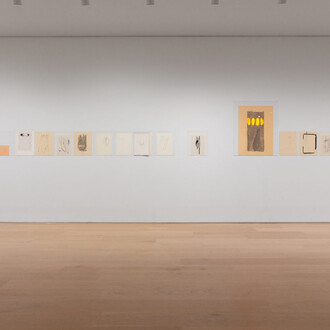The Drawing Center presents Dickinson/Walser: Pencil Sketches, bringing together Emily Dickinson’s original poem manuscripts and Robert Walser’s microscripts for the first time in an art museum setting. Although Walser, who was born shortly before Dickinson died, was most likely unaware of the latter’s work, both writers were obsessively private as well as peculiarly attentive to the visuality of their texts. Walser wrote in tiny, inscrutable script on narrow strips of paper using an antiquated German alphabet that was long considered indecipherable. Only recently have these scripts been shown to consist of early drafts of the author’s published texts. Similarly, Dickinson fitted her multifarious poetic fragments to carefully torn pieces of envelope, newspaper and stationery that were discovered among her posthumous papers. (W. B. Sebald once referred to Walser as a “clairvoyant of the small,” and this description might apply to Dickinson as well.) In both cases, the form of these texts affects the language itself as both writers crafted their words in response to the form at hand. Rarely in literature has the manner in which words are made been so integral to the way in which they might be read.
Dickinson/Walser: Pencil Sketches includes a selection of over 80 works culled from the Swiss National Library/Swiss Literary Archive, which houses Walser’s original manuscripts and first editions, and The Emily Dickinson Collection at Amherst College. In addition, photographs of Walser and the one extant daguerreotype of Dickinson will be displayed on the gallery walls. Among the many works in the exhibition by Walser are: Microscript 9 (1932), written on a card received from a literature editor at the newspaper Neue Zürcher Zeitung who wrote to inform Emily Dickinson, We | talked with | each otherc. 1879. Amherst Manuscript 514; Frankling 1506; Johnson 1473. 1 sheet, Pencil on paper, 5 1/10 x 7 9/10 inches (13 x 20 cm). Courtesy the Emily Dickinson Collection, Amherst College Archives & Special Collections. Robert Walser, Microscript 215, October– November 1928. Pencil on paper, 4 1/16 x 3 13/16 inches (10.3 x 9.6 cm). Courtesy Robert Walser-Zentrum, © Keystone / Robert Walser-Stiftung Bern. Walser that two prose texts would be published; Microscript 337 (1926), a story written on a sheet of a tear-off calendar that was later published in the newspaper Prager Presse; and Microscript 54 (c. 1930–33), written during the period of Walser’s voluntary residence in the Waldau Sanitarium near Bern. Dickinson’s works include poems and letters written on pieces of envelope such as Twas Later When the Summer Went (c. 1873) and The Ditch is Dear to the Drunken Man (c. 1885); and scrap paper such as If It Had No Pencil (c. 1861), a passionate poem about wearing a pencil down to a stub by writing so many unrequited letters to a man she loves. Curated by Claire Gilman, Curator.
Emily Elizabeth Dickinson (1830–1886) was an American poet born in Amherst, Massachusetts. She produced almost 1,800 poems and letters throughout her mostly solitary and reclusive life. After studying at the Amherst Academy for seven years, she spent a short time at Mount Holyoke Female Seminary before returning to her family home in Amherst. With a few exceptions, her poetry remained virtually unpublished until after her death, brought to the attention of a wider audience through the efforts of her family members and close acquaintances. Dickinson's poems are unique for the era in which she wrote; they contain short lines, typically lack titles, and often use slant rhyme as well as unconventional capitalization and punctuation. Many of her poems deal with themes of death and immortality, two recurring topics in letters to her friends.
Robert Walser (1878–1956) was born in Switzerland and worked as a bank clerk, a butler in a castle, and an inventor's assistant while beginning what was to become a prodigious literary career. From 1899 until he was misdiagnosed as a schizophrenic in 1933 and institutionalized for the rest of his life, Walser produced nine novels and more than a thousand stories. Though he enjoyed limited popular success during his lifetime, his contemporary admirers included Franz Kafka, Hermann Hesse, Robert Musil, and Walter Benjamin. Today he is acknowledged as one of the most important and original literary voices of the twentieth century, his work the subject of essays by W.G. Sebald, J.M. Coetzee, William Gass, and Susan Sontag. In the latter years of his career, Walser struggled with a paralyzing writer's cramp that he combated by composing his texts in a miniscule pencil script written on small slips of paper that he carefully cut to size. This handwriting was so small that his guardian Carl Seelig mistook it for a sort of secret code. After his death in 1956 while out on a solitary walk, a collection of these papers were found among his belongings and preserved, but many years passed before they were transcribed and published.



















